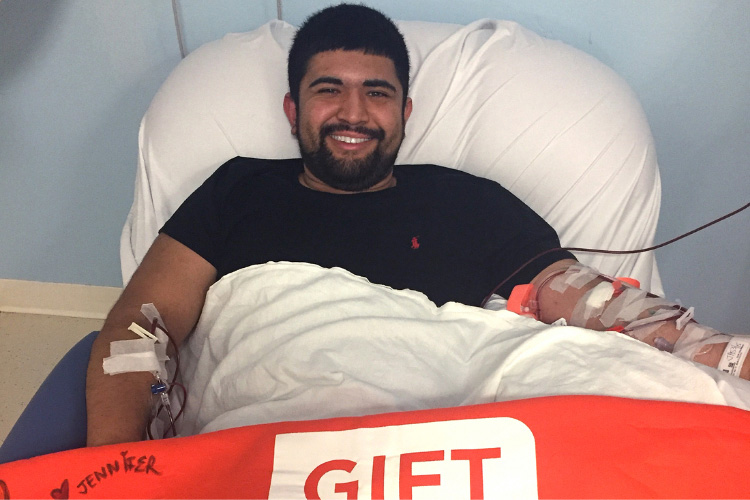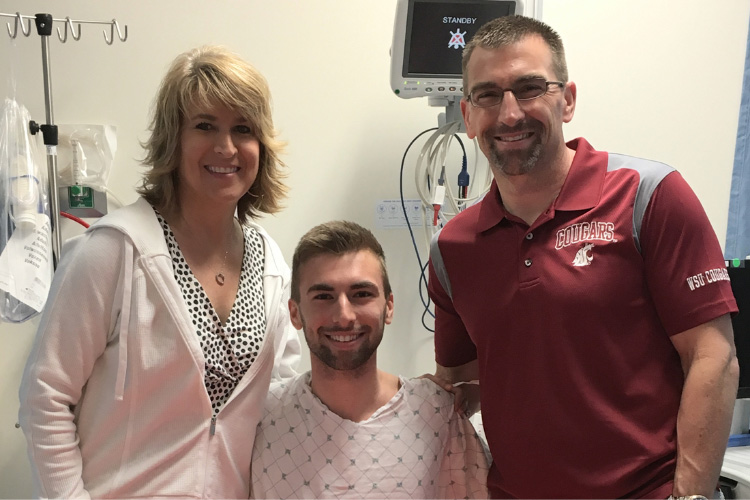







Whether donating peripheral blood stem cells or bone marrow, your donation will help to give your recipient a second chance. One of the first questions every donor asks is, “Will I get the Gift of Life blanket?” Yes! Every donor receives our comfy blanket signed with personal messages of thanks and hope from our staff members.
Remember, donors may bring a companion with them to the collection center, and there is no charge to donors for transportation, airfare, hotel accomodations, and a meal stipend is provided.

Peripheral blood stem cells (PBSC) circulate in the blood stream all the time. Their formal name is hematopoietic [hee-mat-oh-poi-ET-ik] stem cells or hemocytoblasts [hee-moe-SIGH-toe-blasts]; these cells generate all other blood cells. By transplanting them into a patient whose immune system has been completely eliminated, these incredible cells can grow an entirely new immune system for that person – free of cancer or the condition that caused the need. While PBSC are found in great concentration in the bone marrow, a few shots of filgrastim can help your marrow produce extra stem cells, and encourage them to migrate into the circulating blood.
Donors preparing for a PBSC donation will receive injections of Filgrastim for the five days leading up to donation. Filgrastim is a synthetic version of a naturally occurring protein found in the body. The first four days of injections will be given to you by a nurse at a time and location most convenient for you. The fifth injection is given at the collection center on the day of donation.
Filgrastim has been used to prepare donors for close to 40 years, so the effects are well documented. Some donors have no side effects, but others experience symptoms such as bone pain, fatigue, headaches, or nausea, which can be managed with Tylenol®. These symptoms typically disappear within a day of the final injection, sometimes within a few hours after donating. Every person will have a slightly different experience.
Collection of the stem cells is done while you are fully conscious. A needle is placed in each arm, with blood drawn from one arm, processed through a cell-separating (apheresis) machine that identifies and collects only the needed stem cells, then the remaining blood is returned to your other arm. Collection may take 4 to 6 hours, depending on the amount of cells needed for the patient. This depends on the physical size of the patient, for example, a child requires fewer cells than an adult. During the process you are fully awake and can talk with your companion, read, watch movies, or take a nap. You are not able to get up and walk around, and you have limited arm movement.
Once the required number of cells has been collected, the bag of donated stem cells will be turned over to the courier and hand-carried to the transplant center. If the center is overseas, special customs arrangements are in place to prevent delays. In some cases, cells may be cryopreserved before transport.
Most donors find it important to eat soon after collection. You may feel achy or lightheaded after donation, but every person reacts differently. Some donors report they felt perfectly normal a few hours later, and others say it took them a day or two. Most donors can return to work the next day and resume full athletic activities within a few days. Your stem cells will naturally regenerate and return to normal levels on their own.

Preparation for bone marrow donation requires no special injections beforehand. This is an outpatient surgical procedure, completed while you are under general anesthesia. The physician will explain the risks of undergoing anesthesia, and your Gift of Life coordinator is always available to answer any questions you might have. Please note, there is no cost to you for donating.
Once you are asleep , aspiration needles are inserted into the pelvic bone at the iliac crest, in the back of the pelvis. You can easily feel the iliac crest by putting your hands on your hip bones, thumbs forward, palms to your back. The large bones you can feel under your fingers are the iliac crest. A syringe is used to draw out bone marrow. The amount needed is based on the size and condition of the patient; for example, a child requires less than a full-grown adult. No stitches are needed, and when the collection is completed, the site is bandaged, and you are sent to a recovery room until the anesthesia wears off. Some collection centers discharge donors the same day; while others ask donors to remain overnight.
Bone marrow naturally regenerates during the weeks following donation. Some donors feel backache and/or mild fatigue during this time, while others feel normal after a day or two. Those donors who experience stiffness or backache after collection find it is treatable with acetaminophen or similar over the counter medications. Athletic individuals should be able to gradually resume a normal level of activities over the next two weeks. Each person’s experience will vary.
All donors, whether they provide PBSC or marrow, will be contacted by Gift of Life several times during the months following your donation, and again one year, five years, and ten years after donation. We will also contact you when we receive updates from the transplant center about your recipient’s health. Please understand that some transplant centers do not send updates.
Yes, you will go back into the registry as a potential donor for other patients in need or for research opportunities. Sometimes a donor is called to help the same recipient a second time during their recovery. Occasionally a recipient needs a booster to help encourage the transplant to take hold, or they may need an infusion of additional immune system cells to encourage the new system to fully engraft. If either is needed, we will contact you.
Please click on the link below to go on to Step 5 and learn what happens during the transplant.